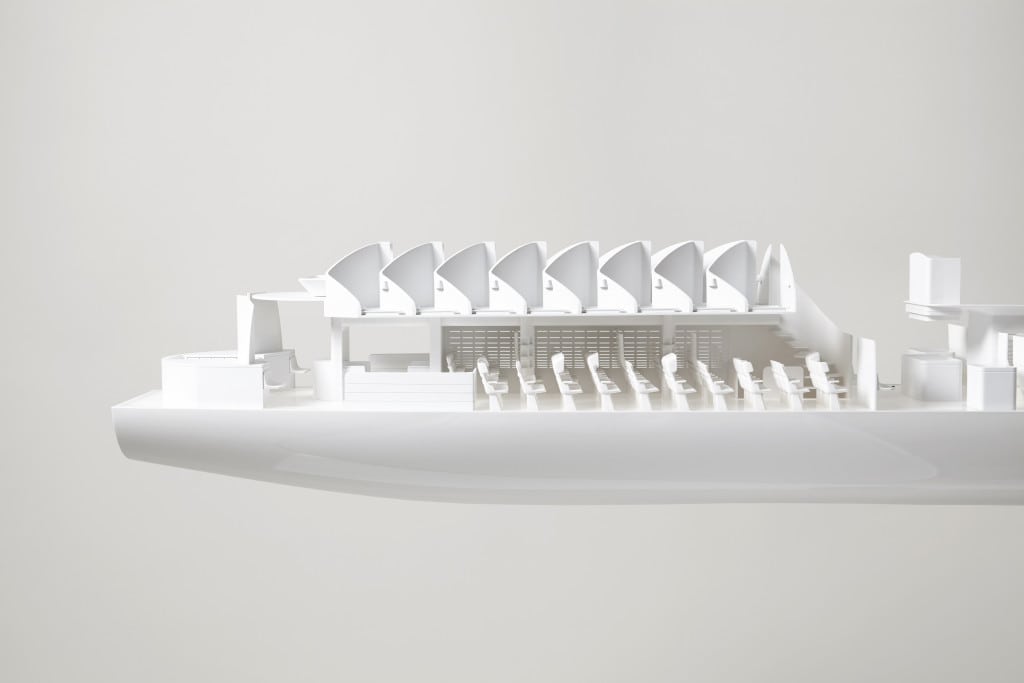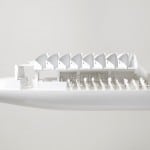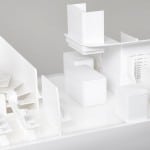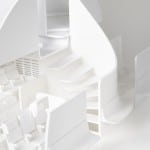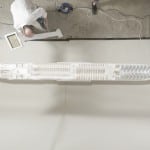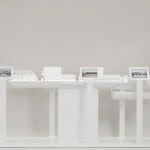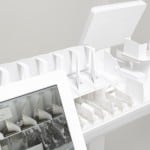Skift Take
We’ve written a lot about airline concepts (seen more concepts than we’ve written about) and have a good feeling about the Life Style cabin. Airlines may not install the whole cabin as illustrated, but some of these concepts have what it takes to make from a blank-canvas model to living-color in the skies.
- The architectural Model of Zodiac’s ‘Desire Lines’ Life Style cabin was brought to life by Territory Studio using augmented reality/Territory Studio
- The architectural Model of Zodiac’s ‘Desire Lines’ Life Style cabin was brought to life by Territory Studio using augmented reality/Territory Studio
- The architectural Model of Zodiac’s ‘Desire Lines’ Life Style cabin was brought to life by Territory Studio using augmented reality/Territory Studio
- The architectural Model of Zodiac’s ‘Desire Lines’ Life Style cabin was brought to life by Territory Studio using augmented reality/Territory Studio
- The architectural Model of Zodiac’s ‘Desire Lines’ Life Style cabin was brought to life by Territory Studio using augmented reality/Territory Studio
- The architectural Model of Zodiac’s ‘Desire Lines’ Life Style cabin was brought to life by Territory Studio using augmented reality/Territory Studio
- The architectural Model of Zodiac’s ‘Desire Lines’ Life Style cabin was brought to life by Territory Studio using augmented reality/Territory Studio
- The architectural Model of Zodiac’s ‘Desire Lines’ Life Style cabin was brought to life by Territory Studio using augmented reality/Territory Studio
- The architectural Model of Zodiac’s ‘Desire Lines’ Life Style cabin was brought to life by Territory Studio using augmented reality/Territory Studio
- The architectural Model of Zodiac’s ‘Desire Lines’ Life Style cabin was brought to life by Territory Studio using augmented reality/Territory Studio
- The architectural Model of Zodiac’s ‘Desire Lines’ Life Style cabin was brought to life by Territory Studio using augmented reality/Territory Studio
- The architectural Model of Zodiac’s ‘Desire Lines’ Life Style cabin was brought to life by Territory Studio using augmented reality/Territory Studio
The future of commercial aviation may not be as bleak as previously imagined, and a new people-friendly flying experience could be closer than many think.
Despite numerous visions of future aircraft dystopias, and present passenger dissatisfaction with the status quo, Zodiac Aerospace’s latest aircraft interiors proposal brings elements from the golden age of flight into a very modern environment, built for and around humans.
Desire Lines
The ‘Desire Lines’ concept of Zodiac Aerospace’s new Life Style cabin breaks the passenger experience free from the binds of the seat, and, inspired by the best practices of urban planning, considers the natural flow of people in spaces.
Dedicated zones in the aircraft let passengers enjoy various activities during a long haul flight: work, entertainment, food, sleep, privacy, socializing, and room to stretch their legs.
Zodiac Aerospace revealed a 1:20 scale architectural model of the alternative aircraft lay-out at the Hamburg Interiors Expo, and Paris Air Show, in a private viewing for airlines, which was intended to spark a dialogue over alternative cabin architecture.
The aim was to balance between the revenue needs of airlines and the needs of passengers for dramatic improvements in today’s long-haul flying experience.
“For Zodiac Aerospace this is the first chapter of an ongoing exploration which reimagines the entire cabin from nose to tail,” says Tom Eaton, head of advanced concepts at Zodiac Seats. “The concept seeks to break up the ‘tube’ of today both architecturally and in terms of service, entirely disrupting the notion of ‘one size fits all.’”
Room to Move
The designers identified underused space around the windows of the aircraft, at the crown and in the cargo well which could be repurposed as zones for sleeping, walking, and snacking. While keeping to profitable density standards, and practical real-world cabin footprint optimization (with a 777-300 aircraft as a baseline model), the designers used monuments to break up the space and monotony, creating areas for passengers to travel individually, or as couples, families, and groups.
In the modular economy cabin, a traditional 9-across seating configuration is transformed into a section with two rows of triples, which can be further separated by movable tide breaks and noise-canceling hoods to create ad-hoc spaces. On the other side of a divider panel, which lets through plenty of light, three seats are divided by a row, making room for passengers traveling alone and for couples.
A light lounge, created by a similar divider on the alternate side of the interior, lets passengers walk, enjoy the view out of the windows, and enjoy self-service snacks and beverages. A convertible galley at the back transforms from a crew service area to a passenger lounge. At the crown of the plane, rows of berths, available for separate booking, let passengers who want to sleep during flight do so in privacy and comfort.
Monuments also clearly demarcate premium cabins from Economy. Premium guests can enjoy restaurant dining service, lounge areas, comfortable seats designed to allow repositioning for work and entertainment, and private apartment berths with full sized beds and sitting areas.
Sparking a Conversation
It’s an ambitious project, and communicating such a departure from the norm of cabin design to change-weary airlines and conservative aircraft manufacturers required a creative approach.
Zodiac Aerospace partnered with digital creatives at Territory, London, to bring their vision to life through augmented reality.
At Pinewood Studios, England, Territory built a 1:1 framework for interior elements of the cabin model, and contracted actors to interact with the cabin. The actors outfitted with sensors at key points in the body, were recorded and the film rendered to a 3-D framework as sketches, which would later be viewed through six touch screens around the architectural model, mounted on a light box. The rendered images of actors moved within the architectural model, demonstrating how the space would be used by passengers in real life.
The videos below show select zones rendered in augmented reality when the model was show to airlines.
Sleeper Service – Private suites for a premium sleeping experience, with a sofa bed, wide screen in-flight entertainment and a social or working space for two passengers.
https://youtu.be/yxbBqxakXYw
Universal Rest (premium sub-cabin) – A premium seat designed to give maximum freedom of movement to the passenger.
https://youtu.be/ue-P-eTvf0Y
Blended Space (lounge) – The layout of the cabin’s amenities is designed to make accessing services like the galleys, lavatories or social spaces a pleasurable and interactive experience.
https://youtu.be/PyiOcd3jEA0
Private Berth – The crown space of an aircraft traditionally dedicated to cabin bins or crew rest is used to offer a private bed to passengers.
https://youtu.be/LpiR5zZ1IDg
Light Lounge (corridor) – The corridor provides a more efficient and pleasant way for people to board, and a relaxed social area for everyone to access, while allowing passengers to move easily around the cabin to support wellbeing.
https://youtu.be/8SZOCi944rM
Modular Economy – A modular and customizable seating system to meet the needs of solo travelers and families.
https://youtu.be/UlVnFdiDDfM
Zodiac Aerospace and Territory hoped to start a conversation about a new way to fly, with the understanding that the entire model is modular and could be adopted in whole or in part. While creating a new passenger experience the Life Style cabin also gives airlines new opportunities for revenue and brand differentiation.
This Future Has a Future
Zodiac reports that it is already discussing the project with airlines, and expects a version of the Life Style cabin could fly within the next ten years.
“This project has been an exhilarating experience of studio collaboration at its most creative,” says Eaton, “Luke and his team at Territory brought a unique skill set to the table that allowed us to explore our vision with extraordinary freedom and speed. I look forward to seeing how it will entice the industry to imaginatively debate the future of aircraft interior design with Zodiac Aerospace.”
The Daily Newsletter
Our daily coverage of the global travel industry. Written by editors and analysts from across Skift’s brands.
Have a confidential tip for Skift? Get in touch
Tags: paxex, zodiac aerospace
Photo credit: The architectural Model of Zodiac's 'Desire Lines' Life Style cabin was brought to life by Territory Studio using augmented reality. Territory Studio
